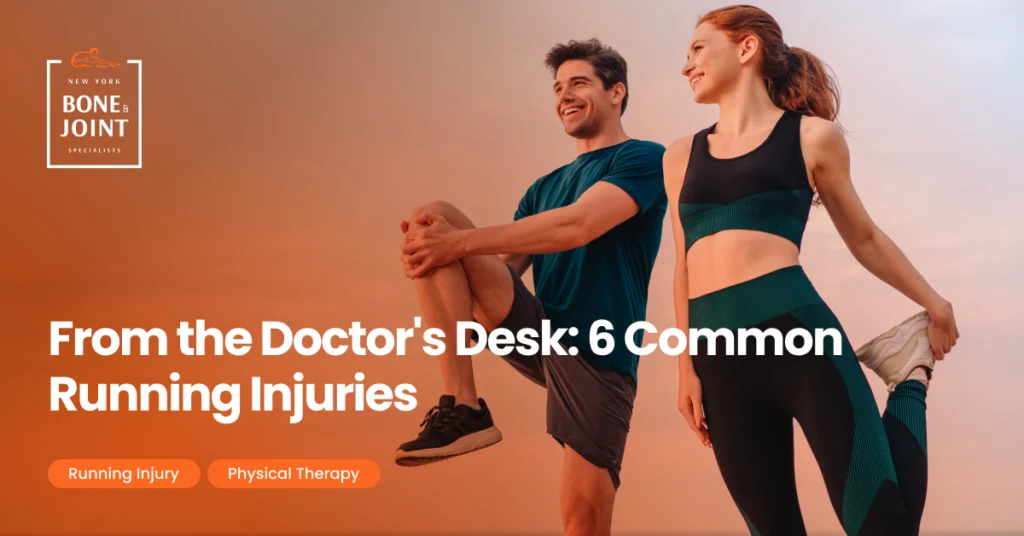Running is a simple way to stay fit. But without the right form or footwear, it can result in injury. In the latest edition of From the Doctor’s Desk, we look at some common running injuries and how to prevent them.
Jogging is a great way to improve cardiovascular health, endurance and strengthen muscles. In addition to the physical benefits, heading out for a jog has also been shown to boost mood and mental well-being.
Requiring just a pair of sneakers, this activity is among the more accessible forms of exercise. However, though it may lack the high impact of football or the risks of skiing, running is not without its share of injury risk.
Here are six of the most common running injuries and how you can take steps to best prevent them.
Common Running Injuries and How to Prevent Them
1. Patellofemoral pain syndrome (Runner’s Knee)
Runner’s knee is a pain that occurs behind the knee and is usually caused by poor form or muscular imbalances. Weak muscles elsewhere in the leg, like around the hip or the quadriceps, can place additional strain and wear on the knee.
To prevent runner’s knee, strengthen your quads (especially the inner ones), work on proper running form, and avoid overexertion. Additionally, cross-training with activities like swimming, weightlifting, and regular stretching/foam rolling can help prevent repetitive knee strain.
2. Medial Tibial Stress Syndrome (Shin Splints)
Medial tibial stress syndrome, commonly called shin splints, is a tightness and pain along the shins. It’s usually the result of overuse of the muscles or poor footwear. Not warming up properly or pushing yourself too hard after a period out of the sport can cause shin splints, too.
To prevent shin splints, you should slowly increase your running distance and avoid rapidly increasing how hard or fast you run.
It’s good practice to run on softer surfaces like grass or dirt to lessen the impact on your joints. You should also invest in a good pair of supportive running shoes to better protect your feet.
Don’t forget to warm up and stretch your legs out before starting every run. Fully flexing before you start can help prevent shin splints.
3. Achilles Tendinitis
Achilles tendinitis is usually caused by overuse of the tendons that attach your legs and feet. Often, this is the result of weak calf muscles. Weak muscles in the calf place additional strain and pressure on the tendons of the ankle.
To avoid Achilles tendinitis, remember to stretch your calves before and after each run, slowly increase your running distance, and get shoes with good heel support. Also, regularly stretch and strengthen your calf muscles to improve flexibility and endurance.
4. Plantar Fasciitis
Inflammation of the plantar fascia at the bottom of the foot is caused by repetitive strain and wearing unsupportive, ill-fitting shoes.
To prevent plantar fasciitis, you should wear shoes with good arch support and stretch your calf muscles regularly. You may also want to consider using orthotic inserts for additional support.
5. Iliotibial Band Syndrome (IT Band Syndrome)
Inflammation of the IT band, a tendon running from the hip musculature to the outside of the knee, can become damaged due to overuse or poor form.
To prevent IT band syndrome, you should regularly stretch and foam roll the IT band and hip flexors. You should also focus on strengthening hip and gluteal muscles, increasing your mileage gradually, avoiding uneven terrain, and wearing shoes with proper cushioning and arch support.
6. Stress Fractures
Stress fractures are small fractures in a bone caused by repetitive impact or stress. The most common stress fracture due to running usually occurs in the tibia.
Stress fractures are also common in the smaller bones of the foot. To much stress on these bones commonly comes from running on hard surfaces and increasing training intensity or mileage too quickly
To prevent stress fractures, you should gradually increase your running distance and avoid running on hard surfaces like concrete. Try running on softer surfaces like grass or trails instead. You may also want to consider cross-training with low-impact activities, like swimming or cycling, and wearing shoes that provide adequate cushioning and arch support.
Running injuries can result in time away from the tracks and trails. However, follow these tips, and you can better prevent troublesome injuries from overuse. If you’re suffering from one of these common injuries, get in touch with me, Dr. Christopher Martin, to discuss how we can get you back on your feet.





